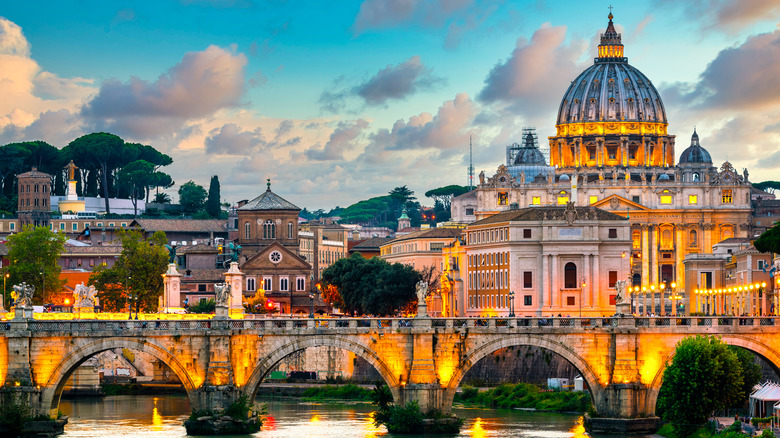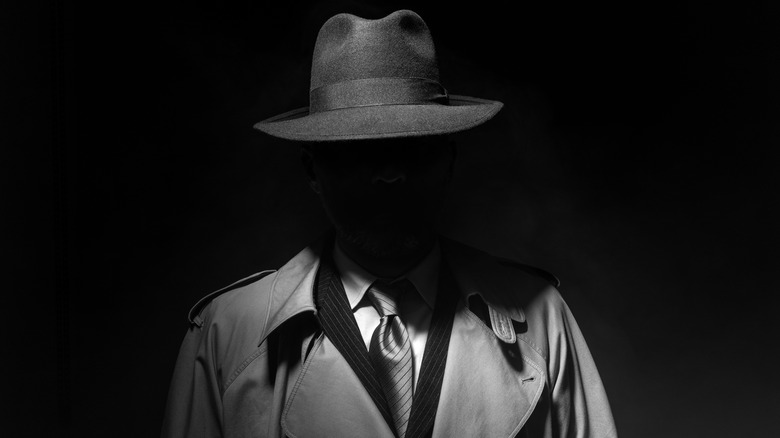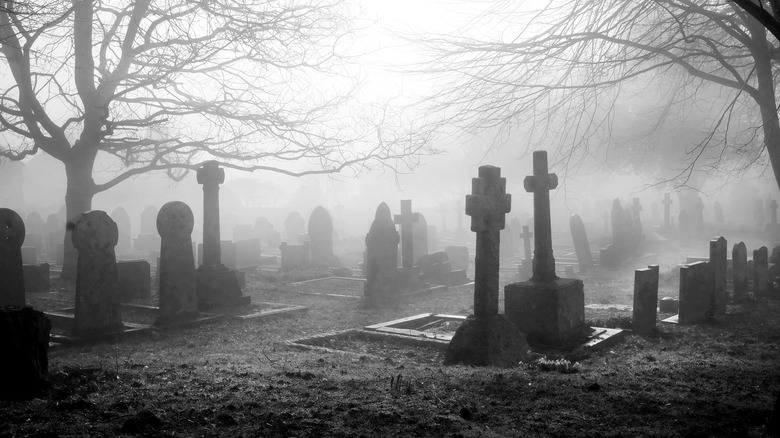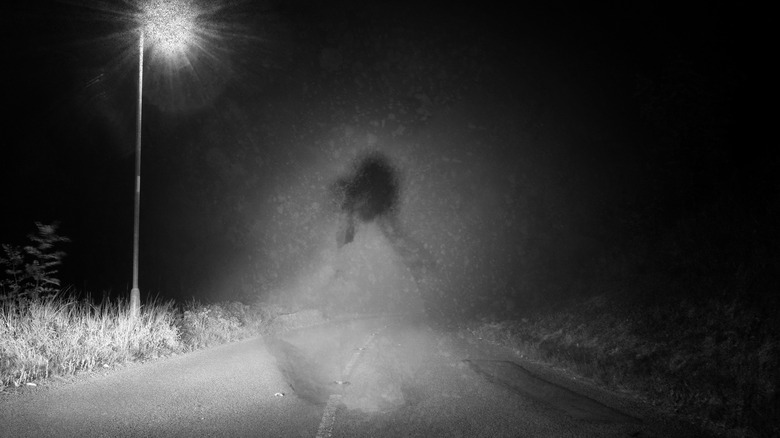The Biggest Emanuela Orlandi Theories: What Really Happened To Her?
On June 22, 1983, 15-year-old Emanuela Orlandi left her parents' Vatican City apartment and walked toward Rome's Sant'Apollinare complex — where she was scheduled for a flute lesson. As reported by Insider, Orlandi arrived for her music lesson as planned. However, her instructor reported that she seemed troubled and asked to leave early.
It has been suggested that she was concerned about a man who stopped her along the way to her flute lesson. Orlandi reportedly called her sister following the encounter to express her concern. According to her sister, Orlandi said the man, who was driving a green BMW, pulled up beside her and offered to pay her to sell Avon products. Orlandi's friends said she boarded a city bus outside the Sant'Apollinare complex at approximately 6:50 p.m. They noted that she was talking to a fellow passenger — who was described as a woman with red hair — when the bus pulled away from the stop. Insider reports that Orlandi never made it home, and it was the last time she was seen alive.
As they were concerned for her safety, Orlandi's parents began searching for the teen and filed a missing persons report with the police. According to HuffPost, authorities initially believed the teen voluntarily left town with a romantic partner. However, the family received some confusing — and disturbing — phone calls in the days and weeks following Orlandi's disappearance. Insider reports one of the first calls they received was from a man who identified himself as Pierluigi.
Several people reported seeing Emanuela Orlandi after she was reported missing
Pierluigi told Emanuela Orlandi's family that his girlfriend spotted the teen in the Campo dei Fiori. In addition to matching the description of Orlandi, Pierluigi's girlfriend said the teen was playing the flute and selling cosmetics for cash. However, the girl insisted that her name was Barbara. As reported by Insider, another man, who identified himself as Mario, contacted Orlandi's family to report meeting the same teen. Although the family received hundreds of reports of sightings and information about their daughter's supposed whereabouts, Insider reports that a vast majority of the callers had misinformation or were playing pranks. However, one call was particularly frightening and sent chills throughout the community.
As reported by HuffPost, Emanuela Orlandi's father, Ercole, was employed by the Vatican Prefecture as a clerk and was in charge of organizing papal audiences. The disappearance of his daughter ultimately prompted Pope John Paul II to make a public appeal for information about the teen's disappearance and her safe return. Within days, the Orlandi family received a call from someone identifying themselves as Emanuela's kidnapper.
The caller contacted the Orlandi family and Vatican officials, claiming he would exchange Emanuela for a man named Ali Agca — who was imprisoned for shooting and injuring Pope John Paul II on May 13, 1981. According to Insider, authorities never determined the identity of the caller. However, they had reason to believe he was an American based on his accent.
The discovery of human bones in the Vatican renewed interest in the case
The man, who authorities referred to as L'Americano, seemed to have documentation that he had at least come into contact with Emanuela Orlandi. In addition to her identification card from the music school she attended, Insider reports that the man provided copies of the sheet music she was studying and likely had in her possession when she vanished. However, it is unknown whether L'Americano actually abducted the teen, as he ceased contact with the family and the Vatican on October 27, 1983, without any exchange having occurred.
Through the years, the Orlandi family received similar claims from other individuals and groups, who also pleaded for Ali Agca's release in exchange for Emanuela. However, none of the supposed kidnappers provided proof that they had the teen. Although Agca was pardoned and subsequently released in 2006, no sign of Emanuela was ever found. In October 2018, construction workers were renovating the floor of a building next to the Vatican's Italian embassy when they discovered fragments of human bones. Crux Now reports that initial testing confirmed the bones belonged to a woman, sparking hopes that they were Orlandi's remains. However, they were ultimately determined to have been buried before the 1980s.
In 2019, Vatican officials authorized the opening of two tombs at the Teutonic Cemetery at the request of the Orlandi family. As reported by Crux Now, the family received an anonymous tip suggesting Emanuela was buried in one of the tombs. Although the remains of dozens of people were found inside the tombs, extensive testing confirmed they were all too old to have belonged to Emanuela Orlandi — all of them were more than a century old.
There are several disturbing theories about what happened to Emanuela Orlandi
Despite the fact that Emanuela Orlandi was never found and authorities have never found any evidence or identified any suspects, there are several intriguing theories about what may have happened to the missing teen. Insider reports journalist and author Pino Nicotri — who has published two books about Orlandi's disappearance — has one of the more disturbing theories about what may have happened to her. In his opinion, Orlandi was abducted by several priests, who may have subjected her to ritual sexual abuse. Nictori also believes the priests provided false tips to authorities to draw attention away from their own involvement.
Journalist Emiliano Fittipaldi also has a disturbing theory that the Vatican was and is aware of exactly what happened to Orlandi. According to Blasting News, Fittipaldi claims he has documented proof that his theory is valid. In 2017, Fittipaldi claimed to have obtained a document, which was described as an "expense report," that reportedly contained evidence that the Vatican was involved in Orlandi's disappearance. As reported by Blasting News, Fittipaldi said the document includes an accounting of activities and expenses related to Orlandi's disappearance in 1983 until her return to the Vatican in 1997.
If you or anyone you know has been a victim of sexual assault, help is available. Visit the Rape, Abuse & Incest National Network website or contact RAINN's National Helpline at 1-800-656-HOPE (4673).
A journalist claims to have proof that Vatican officials know what happened
According to Blasting News, Emiliano Fittipaldi said he obtained the document, which continued five pages of text, from an unnamed source who works in the Vatican. Fittipaldi said the document proves that Emanuela Orlandi was initially transported to London, where she was held in a hostel. He also said that Orlandi was moved to different locations a total of three times between 1983 and 1997.
Fittipaldi said the document was prepared by Cardinal Lorenzo Antonetti and was addressed to Monsignors Giovanni Battista Re and Jean-Louis Tauran. Blasting News reports that Glag Burke, who was the head of the Holy See press office at the time, said the document Fittipaldi obtained was "false and ridiculous" and refused to discuss the issue any further.
Another theory suggests that Orlandi was abducted and possibly killed by Italian crime boss Enrico De Pedis. As reported by The New York Times, De Pedis had a known association with Rev. Piero Vergari, who worked for the Vatican at the time of Orlandi's disappearance. Although he was questioned by authorities at the time, he was never arrested or charged.
Emanuela Orlandi has never been found, and the case remains unsolved
Enrico De Pedis was shot and killed in 1990. However, more information has come to light that has renewed interest in his possible involvement. In 2008, De Pedis' former girlfriend, Sabrina Minardi, claimed that the crime boss arranged Emanuela Orlandi's abduction at the request of Archbishop Paul C. Marcinkus — who formerly headed the Vatican Bank and was implicated in a banking scandal in the 1980s. According to The New York Times, the Vatican vehemently denied rumors of Marcinkus' involvement in Emanuela Orlandi's disappearance. Vatican spokesman Rev. Federico Lombardi said the information came "from a source whose value is highly dubious" and should not be considered trustworthy.
Through the decades, authorities have investigated possible links between Orlandi's disappearance and Bulgarian agents, the KGB, the Sicilian Mafia, and various people associated with the Vatican. However, her whereabouts and current status remain unknown, and the case has never been solved.





